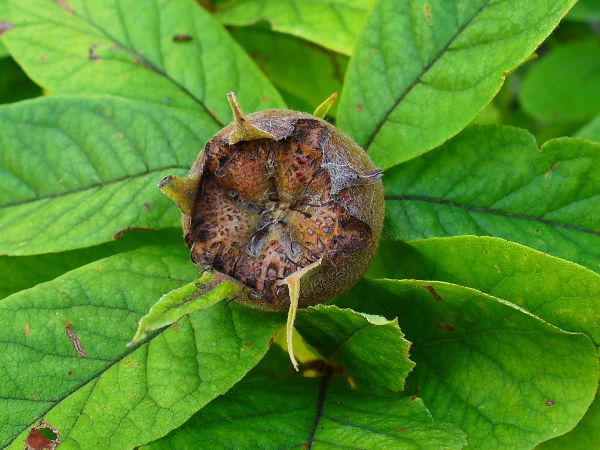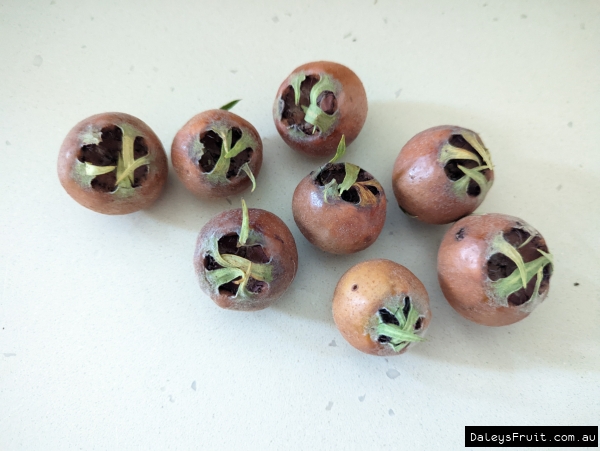
(1/5) Medlar fruit bletted or ripened ready to use
![Medlar fruiting on the tree]()
(2/5) Medlar fruiting on the tree
![Medlar tree laden with fruit in late Autumn]()
(4/5) Medlar tree laden with fruit in late Autumn
![Medler ripening fruit]()
(5/5) Medler ripening fruit
fullscreen1
Medlar
Category
Medlar is native to the eastern part of the Mediterranean and the eastern part of Turkey. While it has been cultivated in Persia for centuries, this highly ornamental fruit tree remains uncommon outside of its centre of origin and there are limited number... Read Mores scattered through the gardens of old homesteads in Australia. The Medlar is closely related to the pear.It is a hardy, long lived deciduous tree which can grow to approx 4 metres in height. The large leaves are oval and downy. The flowers borne in late spring are large and white and resemble single white roses fringed with pink. This broad-crowned tree it has heavy foliage that turns a beautiful reddish-brown in autumn. The unusual fruit are apple shaped with a flat-topped wide open calyx (or ‘eye’) that reveals the five seeded vessels. The fruits are approximately 5cm in diameter and olive green ripening to dark orange and red/brown in late autumn. It is thought that early frosts start the softening process of the fruit, initiating an increase in sugars and therefore a general sweetening of the fruit. Broadly speaking, the flavour is similar to that of a pear. The fruit can be eaten fresh out of the hand when soft or bletted (bletting is similar to the process used in ripening persimmons, leaving them to soften). They may be left on the tree until it drops or can be picked when the fruit is easily removed from the branches. If picked to early the fruit will shrivel or fail to ripen. Eaten while unripe they are very high in tannic acid. In addition to being eaten raw, the fruit can also be used for winemaking. They can be cooked and made into jelly very easily due to the high concentration of pectin in them. The fruit can also be stored by dipping them into a strong salt solution to control fungi, then lay them out singularly, eye down, in a dry cool place until the flesh is soft. This make take several weeks. When kept in a cool place it will keep for weeks, even months during which time a process of fermentation will take place that changes the consistency of the fruit. It becomes soft to touch and brownish in colour. At this stage it can be sucked empty, leaving the skin and stones behind. The consistency of the flesh is rather coarse with a very unique taste to it. There are two cultivars available in Australia. The Dutch and the Nottingham. The Nottingham is a more compact tree with slightly smaller fruit. Both varieties are self - fertile. Planting: The planting site must be in a sunny position and protected from the wind, as the trees are very brittle and susceptible to wind damage. Medlars will grow in most types of soil as long as it is well drained. However, if there is a likelihood of the soil remaining wet for long periods, a medlar grafted onto a quince rootstock would be appropriate. Fertilising and Watering: Medlars have light maintenance requirements. Water requirements are minimal even during the summer period and a light application of manure (3-4kgs) or a couple of light dressings of complete fertiliser in the spring is adequate in most soils. Pruning: Young trees are best if thinned and pruned to desired shape. Established trees require little pruning other than the removal of dead or diseased wood and overcrowded branches. Fruit is borne on the tips of the main shoots and side-growths. The medlar is a relatively slow-growing tree, which means that the wood is rather hard. In earlier days, this wood was used to make spearpoints, clubs and fighting sticks for the hunt and for warfare. Later on the wood was used for making parts of windmills, especially some of the turning wheels.




















